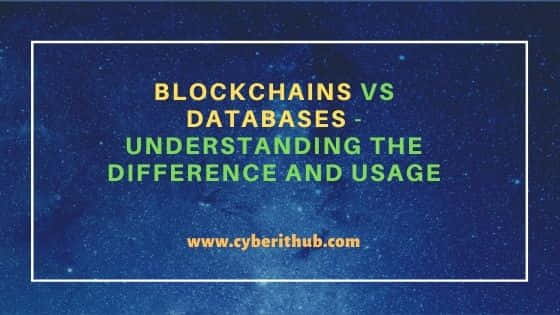In this article, we will try to understand the difference between Blockchains and Databases. Many times it has been observed that people misunderstood the difference between blockchains and databases. Some times it becomes a part of long debate which is better ? Does Blockchain offers all the features that traditional databases has ? Does Blockchain provides a cost effective solution over the traditional databases and so on. There are tons of questions people has it in their mind.
Well, to understand the difference between the two we first need to understand the use case someone has. For example, if we are talking about a use case where application deployment needs to be completely decentralized then implementing blockchain technology will be the ideal solution here. Similarly, if we are talking about a use case where decentralization does not matter much then using distributed databases would be much ideal. Likewise, there could be many more scenario which needs to be understood first before choosing between the either two. More about Blockchain.

Blockchains Vs Databases - Understanding the Difference and Usage
Also Read: Docker CMD vs ENTRYPOINT: Understanding the difference and Usage
1. Blockchains
- A blockchain is a read and append only storage technology.
- All the records are completely decentralized.
- Blocks in a blockchain cannot be updated or deleted.
- There is no administrator required to manage the ledger.
- There is no access control in a public blockchain as it is open for both read and write operations.
- Little to no investment is required to manage the Infrastructure.
- Blockchain inherently provides immutability, security, and redundancy (ISR).
- Since everyone has copy of the record, any unreliable information can immediately be identified and corrected.
- Mostly used for secure transactions purposes.
- With increase in number of transactions, it can becomes slower in performance.
- It cannot go back as data is Immutable.
- Anyone with right Proof of Work can add a new block to the chain.
- Example includes Bitcoin, Ethereum, Circle etc.
2. Databases
- A relational database follows CRUD(Create, Read, Update and Delete) model.
- It can be centralized as well as distributed.
- Data in a database can be updated as well as deleted.
- Database administrator is required to manage the database.
- Access control is required to manage the database operations.
- Usually requires much more investment than the Blockchain to manage the Infrastructure.
- Databases requires additional investment to provide ISR for the data they store.
- Since limited users will have access to database, any unreliable information can only be checked and corrected by those users only.
- Mostly used for storage and retrieval purposes.
- Databases are usually faster than Blockchain Technology.
- It can be rolled back to previous state.
- Anyone having appropriate permission can modify or add data into the database.
- Example includes Oracle, MySQL, SQL Server etc.
